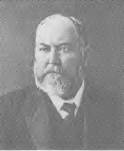- Author
- Ogle, Brian
- Subjects
- History - general
- Tags
-
- RAN Ships
- None noted.
- Publication
- June 1997 edition of the Naval Historical Review (all rights reserved)
Ninety-six years ago on July 9th, 1901 Sir John Forrest, Member for Swan, W.A., and Minister for Defence in Australia’s brand new Commonwealth parliament, moved:
“That this Bill (Defence) be now read a second time“, after which he introduced the first attempt to grapple with the problem of defending an area of 3 million sparsely populated* square miles (*3,700,000 inhabitants in 1901) I will use two of the opening sentences in Forrest’s speech to set a pattern for this paper.
Forrest: “I want to say at the outset that I hope no one in this House will regard me as an encyclopaedia of everything naval and military. I may say, too, that when I took charge of the Department of Defence, I was under the impression that I had not a very arduous duty before me. I regret to say that I have undertaken to control one of the most difficult and one of the most expensive departments of the Commonwealth, one which takes everything in the way of money and gives nothing back“.

Australia’s First Defence Minister
If Sir John Forrest, with the political background of many years as W.A. Premier was inexperienced, many others of the newly elected debates were completely at sea. For example Joseph Cook, future Prime Minister, argued against purchasing River Class destroyers because he thought they were designed solely for river patrol and not for seagoing duties.
The most telling point, however, is Forrest’s stress on “expense which is wholly non-productive”. The Colonies had for 50 years taxed and borrowed to build roads and railways, to reclaim swamps and foreshores, all such ventures eventually showing a return in increased productivity and migration. Not so defence which was a permanent debit.
This theme dominated not only the Defence Bill of 1901 but subsequent debates on the Naval Agreement Act of 1903, the Navigation Bill of 1906 (including the Royal Commission into this Bill). Finally, the Naval Loans Bill of 1909 by which time the necessity for an Australian Navy may have been admitted but how to pay for it was still as hotly contested as it had been since pre-Federation.
One aspect needs consideration; the size of the Budgets of the early Commonwealth and expenditures inherited from the six colonies compared with 1996.
1901-1903 Commonwealth Consolidated Revenues
The following figures were extracted from Commonwealth Parliamentary Acts and Papers. When compared to those of 1996 they provide irrefutable evidence of the growth of Australia as a nation.
Commonwealth Act No. 1 (25/6/1901) of 1901
On May 10 1901 the Governor-General read out the intentions of “his Government” which would transfer the departments of Defence, Customs and Excise and Posts and Telegraphs to the Commonwealth. Among the many promised activities was one that: “they would work to strengthen judiciously – the defence of the Commonwealth, taking care not to indulge in any extravagant expenditure”.
Consolidated Revenue Act No. 1 was passed, “…to provide for expenditure solely for the maintenance or continuance at the time of transfer of Departments transferred from the States of the Commonwealth”. The sum of four hundred and ninety-one thousand, eight hundred and eighty-two pounds (£491,882) was estimated necessary to cover the period to 30/6/1901, when the next budget was due. Defence was allocated £119,600 of which £106,000 was the naval debit for the hire of the Auxiliary Squadron. In addition Defence was debited £43,500 for “Military and Naval demonstrations in connection with the opening of Parliament in Melbourne plus the cost of receptions in Melbourne, Sydney and Brisbane”.
Commonwealth Act No. 3 (12 July 1901)
This provided a grant out of the Consolidated Revenue Fund of one million, seven hundred and thirty-two thousand pounds (£1,732,000) to service all Commonwealth Departments for 12 months to 30/6/1902. The amount seems ludicrously tiny when considered in the light of the necessity to house and staff new departments, pay politicians and their expenses etc. However, Parliamentary Papers for the period disclose that a shorthand-typist cost £160 p.a.; the Speaker of the House was allowed £1,500 p.a. The Navy cost remained static at £106,000.




